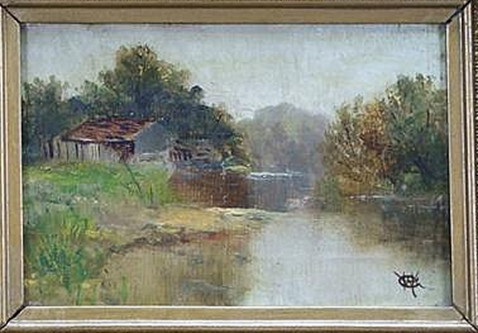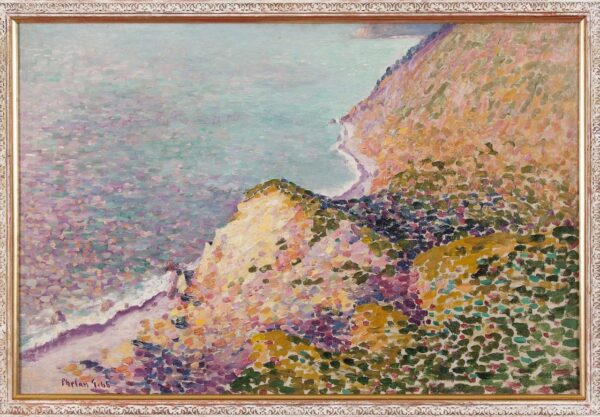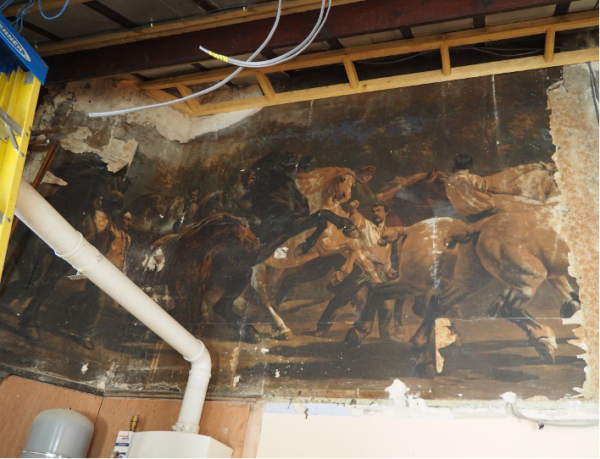Something of an artistic mystery surrounds this Alnwick family.
Now with an exciting update-see the bottom of this page
Thomas Gibb (1832-1895) was a Victorian artist who lived and worked in Alnwick throughout his life. He specialised in landscape paintings in a traditional style which featured hills and moors, cattle and sheep. He had a shop in Bondgate selling his (and other artists) work and offering framing services and artists materials. He was even an official artist for Northumberland County Council. Around 1870 he and his family lived on South Street in a house which is today lived in by one of our volunteers. In 1868 he and his wife Margaret had a daughter, Sarah (Sadie), and a couple of years later a son, Henry (Harry). Two more daughters followed in short order. During the 1870s the family moved to Clayport Street. He must have been doing well financially because in 1882 he then commissioned a house to be built at the top of Upper Howick Street in what is now known as Beaconsfield Terrace. His initials, THG, can still be seen in stone above the front door. The house contained a large high ceilinged, north facing artist’s studio.
![]()
Sadie and Harry were both very interested in art and were taught painting by their father before training in Newcastle, Edinburgh and elsewhere. Harry indeed must have been a precocious talent, as there is a small signed and dated oil painting by him from 1883 when he was only 12 or 13. (below)

When Thomas Gibb died in 1895 the family seem to have moved to Grosvenor Terrace, where in 1901 Harry and Sadie are sharing the house, and both are described in the census as ‘artists’. Harry by then had inserted his grandmother’s name in his own and referred to himself as Harry Phelan Gibb. A painting entitled Winter, Hulne Parks, 1903, shows that Harry was still painting in a very traditional style very much like his father’s work, and was still living in Alnwick.

Hulne Park 1903 By H P Gibb
Not long after this Harry travelled to the heart of modern European art, to Paris, and there his work underwent a dramatic transformation. He met and saw the work of artists such as Monet, Seurat, Cezanne, Matisse and so on. Indeed, he shared a studio in Southern France with Matisse for a time. Almost overnight he became a ‘modern’ artist. He became friendly with Gertrude Stein, the American author who promoted the avant-garde in Paris. Gertrude was convinced that the two painters of her generation that would be discovered after they were dead were Juan Gris and Harry Phelan Gibb. She was right about Gris but not about Harry Phelan Gibb. Perhaps the problem was that he experimented with lots of different styles as can be seen below:



Above, works by Harry Phelan Gibb
Harry returned to Britain during the Great War and lived in London and Devon until his death in 1948. He continued to paint, and also explored working in ceramics, but had limited commercial success.
So where is the mystery? The house at Beaconsfield Terrace has had many alterations over time, and recently changed hands. The new owners are in the process of stripping out many of the alterations that have been done over time and restoring the house to something closer to its original state. A short while ago they (or at least their plasterers) took down the false ceiling that had been installed in what was the original artist’s studio and were surprised to find a very large wall painting on what would have been the upper part of the studio wall. We were recently invited to take a look at it, and you can see aspects of the work below. It is painted on lining paper rather than on the bare plaster, and measures about 10 feet by 6 feet.

![]()
![]()
It seems more likely that this was the work of Harry, or even Sadie, who were both learning about painting when they lived in the house. Perhaps it was an opportunity to paint on a scale, and in a style which wasn’t possible when painting for the commercial market.
UPDATE
Since this was originally posted a part of the mystery has been solved, namely the identity of the original work on which the mural is based. The solution is a great example of serendipity. At a social event in the South of England the owners of the house entered into conversation with another guest called Hayley Tomlinson. She happens to be a professional art conservator at the National Gallery. When she was shown a photo of the mural she not only immediately recognised the work on which it is based but revealed that she had just been doing some conservation work on that very painting!
The original work is a painting called The Horse Fair painted in Paris by the French artist Rosa Bonheur in 1853. The painting was exhibited at various locations in Britain in the 1850s and Bonheur painted some smaller versions which were owned by British people. One of these smaller versions is owned by and on display at the National Gallery in London. It was also the subject of many prints. It seems most likely that the Gibbs either saw the painting on a visit to London or owned a copy of a print and used it as an inspiration for the mural. The original painting has been in the Metropolitan Museum of Art in New York since 1887.

